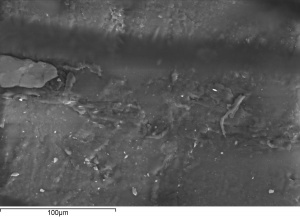Difference between revisions of "Salted paper"
| Line 5: | Line 5: | ||
[[[SliderGallery rightalign|salt print sample 16 site2.jpg~SEM]]] | [[[SliderGallery rightalign|salt print sample 16 site2.jpg~SEM]]] | ||
| + | |||
| + | |||
| + | |||
| + | |||
| + | |||
| + | |||
| + | |||
| + | == Additional Information == | ||
== Synonyms and Related Terms == | == Synonyms and Related Terms == | ||
Revision as of 09:13, 1 July 2014
Description
A type of photographic Printing out paper. Developed by William Henry Fox Talbot, salted paper was prepared by directly soaking paper in a solution of table saltthen treating it with Silver nitrate. By 1841, salted paper was made with a thin salt-filled Gelatin coating that was dried then treated with silver nitrate to form a photosensitive silver halide compound. Gelatin was most commonly used as a binder, but other materials such as Albumen, Arrowroot starch, Agar-agar, and Starch were also used. The image was produced by exposing the paper to the sun through a negative then fixed with Potassium bromide or Sodium thiosulfate solutions. By the 1860s, salted paper was replaced in popular use by Albumen paper.
Additional Information
Synonyms and Related Terms
salt print; salted-paper; plain salted paper; papier salé (Fr.)
Additional Images
Authority
- Caring for your Collections, Arthur W Schulz (ed.), Harry N. Abrams, Inc. , New York, 1992 Comment: one of the earliest photographic printing process introduced in 1841
- James M. Reilly, Albumen & Salted Paper Book: The history and practice of photographic printing, 1840-1895, Light Impressions Corp., Rochester, NY, 1980 Comment: see chapter at http://albumen.stanford.edu/library/monographs/reilly/chap11.html
- E.J.LaBarre, Dictionary and Encyclopedia of Paper and Paper-making, Swets & Zeitlinger, Amsterdam, 1969
- Luis Nadeau, Encyclopedia of Printing, Photographic, and Photomechanical Processes, Atelier, New Brunswick, 1997
- Thomas B. Brill, Light Its Interaction with Art and Antiquities, Plenum Press, New York City, 1980








